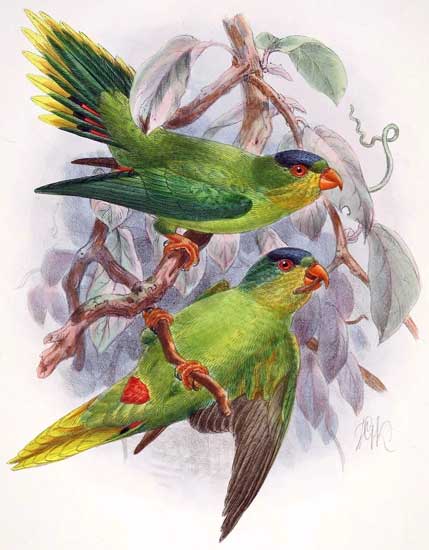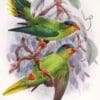New Caledonian Lorikeet
Also known as:
Diademed Lorikeet, New Caledonian Diademed Lorikeet
Also known as:
Diademed Lorikeet, New Caledonian Diademed Lorikeet
DID YOU KNOW?
The New Caledonian Lorikeet is known only from two females found before 1860, and unconfirmed sightings in the 1950s and 1976.

Charmosyna

diadema
Size:
19 cm (7.4 in)
Weight:
Not recorded.
Subspecies including nominate:
one
Colour Adult:
Male-undescribed. Female-in general green; yellow cheeks and throat; purple/blue crown; olive/brown wash on mantle; purple/blue wash on thighs; red vent; green tail, with red at lateral feather bases. Beak orange/red.
Colour Juvenile:
Not recorded.
Call:
Not recorded.
More Information:
Content Sources:
CITES
BirdLife International
Cornell Lab of Ornithology/Birds of the World
A Guide to Parrots of the World, Juniper and Parr, 1998
Parrots of the World, Forshaw, 2006. 2010 edition
Vanished and Vanishing Parrots, Forshaw, 2017.
Captive Status:
Not found in captivity.
Longevity:
—
Housing:
—
Diet:
—
Enrichment:
—
Nest Box Size:
—
Clutch Size:
Not recorded.
Fledging Age:
—
Hatch Weight:
—
Peak Weight:
—
Weaning Weight:
—
World Population:
< 50, with no sightings since 1976.
IUCN Red List Status:
Critically Endangered
CITES Listing:
Appendix II
Threat Summary:
A BirdLife ‘restricted-range’ species. Possibly has requirements for lowland semi-deciduous forests, which have almost disappeared from the island. Also, introduced diseases (avian malaria) or predators may have caused it to decline.
Range:
Recorded from Viti Levu, Vanua Levu, Ovalau and Taveuni, Fiji Islands.
Habitat:
Forest edge of rainforest near to Melaleuca woodland.
Wild Diet:
Presumably pollen and nectar.
Ecology and Behaviour:
Reports early on indicated that this lorikeet lived in forest and sometimes fed in Erythina trees (Layard and Layard 1882). It is thought that it and closely-related Charmosyna range into lowland forests from mountain forest, depending on the season (Forshaw 1989).
Clutch and Egg Size:
Not recorded.
Breeding Season:
Possibly July-December

